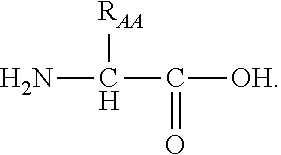Reprogramming of somatic cells with purified proteins
- Summary
- Abstract
- Description
- Claims
- Application Information
AI Technical Summary
Benefits of technology
Problems solved by technology
Method used
Image
Examples
example 1
Reprogramming of Mouse Embryonic Fibroblasts
[0198]MEF cells (ATCC catalog no. SCRC-1008) were plated at 1.13×105 cells per well on a 6-well plate (day 0) and incubated overnight in HDF medium. On day 1, the cells were treated with three purified somatic cell reprogramming factors operatively linked to the TAT peptide (m-Oct4 at 15.6 nM, m-Sox2 at 34.1 nM, at m-Klf4 22.5 nM), GFP-TAT fusion protein, VPA (2 mM) and sodium azide (0.002%). Three days later (day 4), the media was replaced and cells were treated with the same components at the same concentration. The cells were then harvested from the dishes on day 7, and frozen at −80° C. Upon thawing on day 8, the cells were put onto mitomycin-treated MEF cells (feeder) in ES cell culture basal medium (“ES-cm,” containing 10% FBS in DMEM / F12 supplemented with 2 mM glutamine, 1×MEM NEAA, 100 μM 2-mercaptoethanol, 4 μg / mL β-FGF, 100 U / mL penicillin, and 100 μg / mL streptomycin). The medium in each plate was changed daily.
[0199]On day 20, s...
example 2
Reprogramming Human Dermal Fibroblasts with Three Purified Somatic Cell Reprogramming Factors
MEF-MITC Feeder Cell Preparation
[0201]0.1% gelatin solution was added to the wells of a 6-well cell culture plate and incubated for 45 minutes in a 37° C. / 5% CO2 incubator. Gelatin solution was removed prior to plating cells. MEF-MITC were plated at 1.6×105 cell per well on gelatin coated 6 well plates. The feeder cells were allowed to grow for 24 hours in a 37° C. / 5% CO2 incubator.
[0202]HDFn cells were plated at 2.11×105 cells per well on a 6 well plate and incubated overnight. Three purified somatic cell reprogramming factors (each operatively linked to the TAT peptide) (m-Oct4 at 15.6 nM, m-Sox2 34.1 nM, m-Klf4 22.5 nM), GFP-TAT chimera, VPA (2 mM) and SA (0.002%) were added on day 1, day 2 and day 3, in HDF-culture medium. Before addition of the compounds on each day, the medium in each well was changed. On Day 9, cells were transferred to MEF-MITC feeder cells.
[0203]On day 9, treated HD...
example 3
Reprogramming of Human Dermal Fibroblasts with Three Purified Somatic Cell Reprogramming, Factors, Valproic Acid, Sodium Azide and Vitamin C
[0205]Human dermal fibroblast (HDF) cells were plated in HDF medium, at 4×105 cells per well in a 6-well plate (day 0). The cultures were incubated overnight in a 37° C. / 5% CO2 incubator. The HDF medium was then replaced, and the cell cultures were treated with purified somatic cell reprogramming factors m-Sox2 (34.1 nM), m-Klf4 (22.5 nM), m-Oct4 (15.6 nM), as well as 2 mM valproic acid, sodium azide (0.002%), and vitamin C (10 μM) (day 1). The cultures were incubated for 24 hours in a 37° C. / 5% CO2 incubator. The next day (day 2), the medium was replaced with fresh HDF medium. Cells were then treated as on day 1. The cultures were again incubated overnight in a 37° C. / 5% CO2 incubator.
[0206]On day 3, the HDF medium was replaced with HEScGRO Basal Medium for Human ES Cell Culture from Millipore (presently Millipore catalog no. SCM020-100). Cells...
PUM
 Login to View More
Login to View More Abstract
Description
Claims
Application Information
 Login to View More
Login to View More - R&D
- Intellectual Property
- Life Sciences
- Materials
- Tech Scout
- Unparalleled Data Quality
- Higher Quality Content
- 60% Fewer Hallucinations
Browse by: Latest US Patents, China's latest patents, Technical Efficacy Thesaurus, Application Domain, Technology Topic, Popular Technical Reports.
© 2025 PatSnap. All rights reserved.Legal|Privacy policy|Modern Slavery Act Transparency Statement|Sitemap|About US| Contact US: help@patsnap.com

